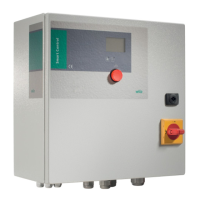40 WILO SE 05/2016 V05 DIN A4
English OPERATION AND FUNCTION
POTENTIALLY fatal danger due to electrical
voltage!
When performing work on the uncovered
switchgear, there is a risk of fatal electric
shocks occurring. All work on individual
components must be performed by a qualied
electrician.
NOTE
Following a power supply interruption, the
switchgear will automatically start up in the last
operating mode set!
6.1. Operating modes and operation principle
The switchgear can distinguish between the
followingtwooperatingmodes:
• Empty
• Fill
NOTE
To change the operating mode, all pumps must
be deactivated. For this, set the value “OFF” in
menu 3.1.0.0.
6.1.1. “Empty” operating mode
The reservoir or pump chamber is drained. The
connected pumps are activated when the level
rises and switched off when the level falls. This
control is mainly used for water drainage.
6.1.2. “Fill” operating mode
Thereservoirislledup,forinstance,topump
water out of a well into a rainwater storage tank.
The connected pumps are activated when the
level falls and switched off when the level rises.
This control is mainly used for water supply.
6.1.3. Operating principle
In automatic mode, the connected pump(s) are
actuateddependingonthelllevelsdened.
Measurementoftheindividuallllevelscanbe
performedviaaoatswitchoralevelsensor:
Fig. 3: Illustration of the switching points with a oat switch in the
“Empty” operating mode using the example of two pumps
1 Base-load pump ON 4 Dry-running protection
2 Peak-load pump ON 5 High water
3
Base-load and peak-
load pump OFF
• Levelmeasurementviaaoatswitch
Uptoveoatswitchescanbeconnectedtothe
switchgear:
• Base-load pump ON
• Peak-load pump ON
• Base-load and peak-load pump OFF
• Dry-running protection
• High water
This enables actuation of 1 or 2 pumps.
TheoatswitchshouldbeequippedwithanNO
contact i.e. on reaching or exceeding the switch-
ing point, the contact is closed.
Fig. 4: Illustration of the switching points with a level sensor in the
“Empty” operating mode using the example of two pumps
1 Base-load pump ON 5 Dry-running protection
2 Base-load pump OFF 6 High water
3 Peak-load pump ON 7
Dry-running protec-
tion*
4 Peak-load pump OFF 8 High water*
*Alsorealisedviaaoatswitchforincreasedoperational
reliability.
Fig. 5: Illustration of the switching points with a level sensor in the
“Fill” operating mode using the example of a submersible pump
1 Pump ON 3 High water
2 Pump OFF 4 Low water
5
Dry-running protection for submersible pump (realised
via the “External OFF” contact)
• Level measurement via a level sensor
A level sensor can be connected to the switch-
gear, with which up to 10 switching points can be
dened:
• Base-load pump On/Off
• Peak-load pump 1 On/Off
• Peak-load pump 2 On/Off
• Peak-load pump 3 On/Off
• Dry-running protection
• High water
This enables actuation of 1 to 4 pumps.
Onreachingtherstactivationpoint,thebase-
load pump is switched on. When the second
activation point is reached, the peak-load pump
is cut-in after the set activation delay time has
elapsed. A visual indicator appears on the LC
display and the green LED lights up while the
pump(s) is/are in operation.
On reaching the deactivation points, the base-
load pump and peak-load pump are switched off
after the set stop delay and the set follow-up
time for the base-load pump have elapsed.
To optimise pump running times general pump
cycling can take place each time all pumps are
switched off or periodical pump cycling depend-
ing on a preset operation time can take place.
During operation, all safety functions are active.
In case of one pump malfunctioning, automatic
changeover to a fully-functional pump takes
place. An optical alarm signal is output and the
collective fault signal contact (SSM) is active.
Once dry run level or high water level is reached,
a visual alarm signal is output, the collective fault
signal contact (SSM) and high water alarm contact
(onlyincaseofoverow)areactive.Inaddition
forced switch-on or switch-off of all available
pumps takes place to increase operational relia-
bility.

